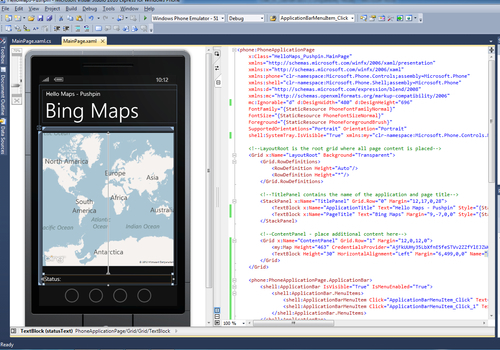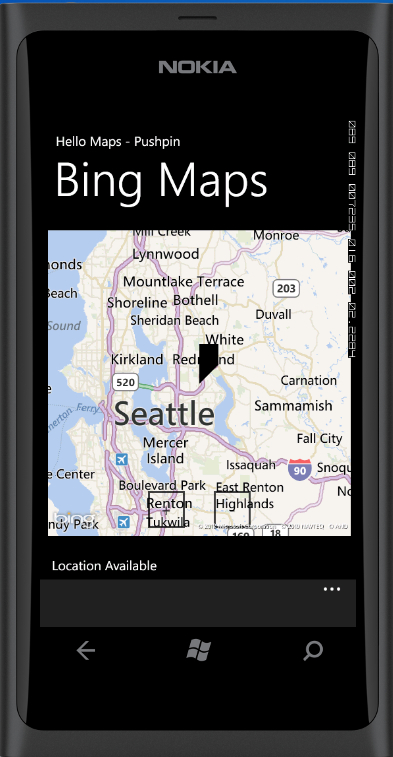We have seen how to change map modes, however just a simple map without any focus does not make much sense, does it? So we move further and modify the HelloMaps example by using the Windows Phone Location Service to add a pushpin to the map — signifying the user's detected location.
The Pushpin class is part of the Microsoft.Phone.Controls.Maps namespace, with location as one of the properties. So let's use this property in our code and render a simple pushpin:
- We start by creating a new project titled
HelloMaps-Pushpin. - From our
HelloMapsexample, reintegrate the same UI, maps, and text labels, and from ourHello Locationexample, import theTextBlocknamedstatusText. Your UI should now look like the following screenshot:
- Open
MainPage.xaml.csand copy over the location variable and methods from theHello Locationexample. Add a variable in the global scope calledzoomLevelthat controls your map's zoom level.GeoCoordinateWatcher locationManager; double zoomLevel = 10.00;
- Now in your
MainPage()constructor copy over the location manager code from the Hello Location example, and for your map, setZoomBarVisibilitytoVisible. This property is from theMapclass that allows the zoom in/zoom out control to be visible on the map. The following is your constructor code:public MainPage() { InitializeComponent(); locationManager = new GeoCoordinateWatcher(GeoPositionAccuracy.High); locationManager.StatusChanged += new EventHandler<GeoPositionStatusChangedEventArgs> (locationManager_getStatus); locationManager.PositionChanged += new EventHandler<GeoPositionChangedEventArgs<GeoCoordinate>> (locationManager_getPosition); myMap.ZoomBarVisibility = Visibility.Visible; locationManager.Start(); } - The
StatusChangedevent handlerlocationManager_getStatusremains similar to theHello Locationexample, however thePositionChangedevent handler undergoes a few changes by adding a new pushpin at the detected location. - We begin the
PositionChangedevent handler function by creating a new pushpin namedmyPin. TheLocationproperty of thePushpinclass is then used to transfer the hardware's detected location to the pushpin by the following lines of code:void locationManager_getPosition(object sender, GeoPositionChangedEventArgs<GeoCoordinate> newLoc) { Pushpin myPin = new Pushpin(); myPin.Location = new GeoCoordinate(newLoc.Position.Location.Latitude, newLoc.Position.Location.Longitude); - Now we add this pushpin to the map by using the
Childrencollection of theMapclass as: - Lastly, we change the map's current view to the detected location to focus the map at that geocoordinate and specify a zoom level.
myMap.SetView(new GeoCoordinate(newLoc.Position.Location.Latitude,newLoc.Position.Location.Longitude), zoomLevel);
- Running the application in the emulator produces the following result:

- Now open up the Location simulator and select a few locations around Paris. Do it one at a time and see the real-time pushpin magic!!

You can find this example project in the code files for the book underChapter 3, titled HelloMaps-Pushpin.
..................Content has been hidden....................
You can't read the all page of ebook, please click here login for view all page.
